Aerial view of the neutrino beam line ('98.02).
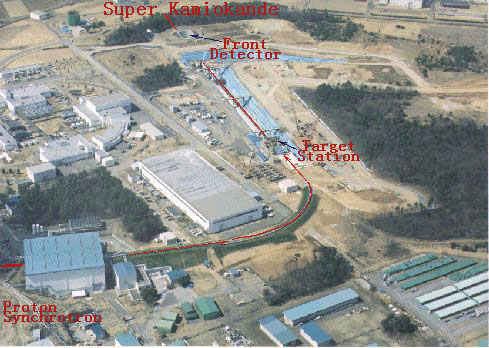
The bending section from the building at the bottom left is the end of the proton beam line which now extends to the target station near the center of this photo. The straight section in the upper middle of this picture (pointing just to the left of up) is the decay tunnel for pions. Near the top, just before the trees, one just can see the round hole where the front detector hall is built. The kiloton water Cherenkov detector, fine grain detector, lead glass array, and muon range stack will all operate in this hall.
The magnetic horn is waiting to be installed.

After the proton beam strikes our aluminum target and makes pions, we focus those pions with a pair of "horn magnets" (named for the shape of the inside part) to make them travel straight along the decay tunnel. By doing this, we are able to increase the number of neutrinos that reach our far detector by a large factor. The horns are produced and have been tested both mechanically and electrically. Soon, we will place them in the target station at the end of the proton beam line.
The beam line magnets are being installed. ('98.07)

This is for the last section of proton transport before the target station (-the curved section in the above photo).
The experimental hall ('98.05).
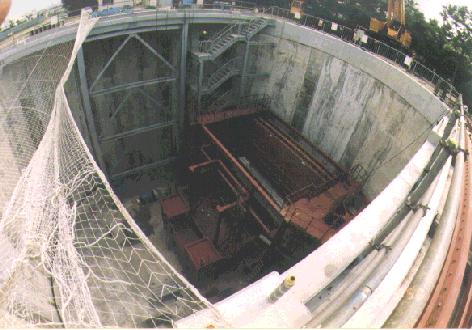
As of July, 1998, the iron plates for the muon ranger, the full lead glass detector, and the tank for the 1 kiloton of water are all installed. (See below!) In this view of the hall, the beam will come from approximately the bottom left. The dark red (painted) structure in the photo is support for the muon ranger and the lead glass detector.
The muon ranger's iron plates being installed ('98.06).
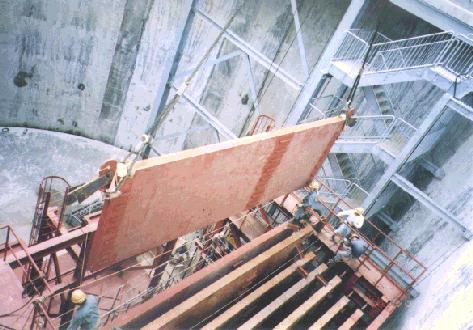
The iron plates for the muon range detector are now all in place, and have holders (not in picture) for the wire chambers attached to them. By following muon tracks through these plates, we can measure the spectrum of muons produced by neutrino interactions very well.
The lead glass detector was installed in the experimental hall. ('98.06)
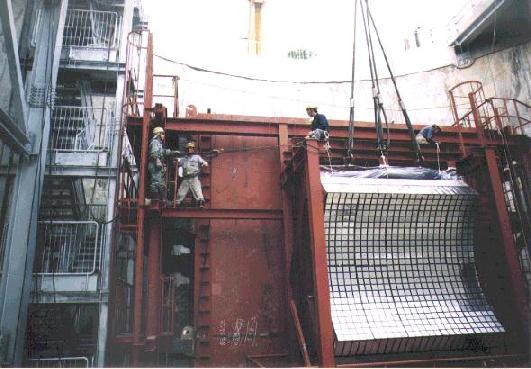
This view is almost along the beam direction. The array of lead glass detectors will measure how many electrons are produced in the fine grain detector. This is very important to know so that we can predict any background of expected electron neutrino interactions in Super-Kamiokande.
SCIFI sheet making ('98.06)

The fine grain "SCIFI" (SCIntillating FIber) detector will measure the neutrino flux with very precise information on position and direction of produced particles. Each fiber is 700 microns in diameter. Many layers of fiber sheets are arranged between water target containers. This ability to measure the position and direction accurately is necessary to verify our understanding of the beam distribution and our physics interaction models that we use in data analysis.
After production of all sheets, the sheets and target modules will be installed in the front detector hall just in front of the lead glass detector.
The 1 Kton water Cherenkov tank was installed in the experimental hall. ('98.07)
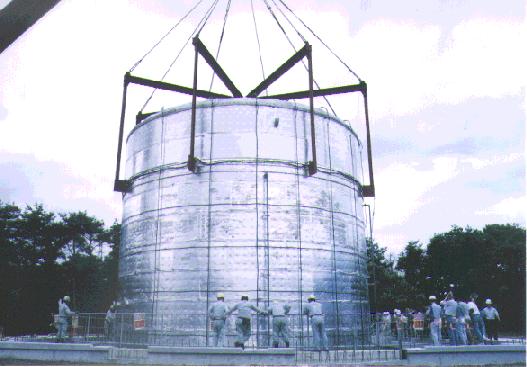
This is an action photo of lowering the tank into its place for the experiment. Moving a large steel tank is not as easy as it sounds when it is that large! This 9 meter structure must be placed with an accuracy of at worst a few millimeters. The "spider" structure on top is for lifting the 40 ton can; it will be removed soon. The tank looks shiny because it is wrapped in an insulating layer to make it easier to control the water temperature. The thin vertical lines that go from the top all the way down are part of a system of magnetic coils to cancel the magnetic field of the earth. Soon, this tank will be filled with one thousand tons of very pure water as several hundred ultra-sensitive light detectors ("photo-multiplier tubes", or simply "PMTs") are installed. Then it will be ready to detect neutrinos the same way that the far detector Super-Kamiokande has been doing for its observation of atmospheric neutrinos. This similarity is crucial to verifying that all of our detectors are properly understood.